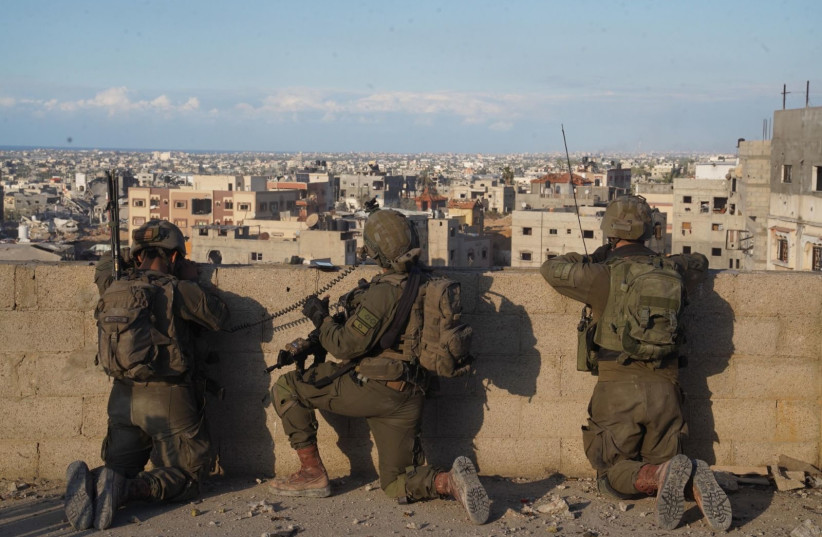Charting Hamas’s losses over more than 100 days of war with Israel, there are some critical data points:
On the positive side: 48-60% of Hamas’s forces are out of commission – meaning either killed, wounded, or arrested.
On the negative side: the IDF killed around 3,500 in northern Gaza in the initial three weeks of the invasion, but has only killed around 2,000 more in the last six weeks, indicating that elimination of Hamas forces has dropped steeply.
The IDF estimates it has killed 9,000 Hamas terrorists, wounded around 8,000 to a degree that they cannot easily return to battle (a much larger number have been wounded at lower levels), and has arrested 2,300.
This means 19,300 can no longer fight.

WSJ reported the number of dead, but not the number removed from battle
When The Wall Street Journal published a report citing US officials estimates that the IDF had only killed around 20-30% of Hamas’s forces, the report mentioned, but did not add together all of the elements of removing Hamas forces from the battlefield. So the WSJ figures did not encompass capture the whole picture.
But the most relevant question is how many battle-ready Hamas fighters remain. The problem is that the IDF has provided many different estimates of Hams numbers.
Prior to the war, many reports estimated Hamas forces at 40,000 strong.
Eventually, the IDF went on record with The Jerusalem Post and others at 30,000.
But there were still some IDF officials who went off-script and held to the estimate of 40,000.
The discrepancy could be due to imperfect intelligence or a failure to distinguish combat fighters from Hamas logistics support forces who do not really fight.
Unofficial estimates before the five-day conflict in May 2023 said Islamic Jihad had set its forces, separate from Hamas, at around 10,000.
IDF sources indicated that on the eve of the current war, Islamic Jihad forces had diminished, possibly due to losses during the May 2023 conflict.
Top defense officials seem unsure how to distinguish Hamas and PIJ fighters given that they have cooperated in fighting Israel since October 7.
Rate of killing Hamas fighters has dropped significantly
In the first week of the war the IDF killed 1,500 Hamas terrorists in the battle to expel the organization from Israel’s South. Until October 27, Gaza was bombed, but not invaded, so there was no fixed number of Hamas operatives killed but some top Hamas officials were assassinated from the air.
The IDF’s best weeks were October 27-November 15 when it killed 3,500 Hamas fighters in 20 days, bringing the total dead Hamas forces number up to 5,000.
These included ground battles over Hamas’s military headquarters, its parliament, and areas near its Shifa Hospital command center.
Before Hamas realized how serious the IDF was about a full-scale invasion it believed it was worth fighting above ground in large formations to try to bloody the IDF enough to halt the entire invasion.
However, from November 15-23, the sides entered serious hostage and temporary ceasefire negotiations which stopped the fighting from November 23-30.
The IDF’s next best time period was December 1-10 when it killed around 1,000 Hamas terrorists in a week, mostly during the initial battles in Khan Yunis, southern Gaza, in Shejaia in northern Gaza, and in central Gaza.
By December 10, 7,000 Hamas terrorists had been killed.
Progress started to slow as Hamas retreated underground and it took 14 days, until December 24, for the IDF to kill another 1,000 Hamas forces, to get to 8,000 killed.
Since December 24, the IDF has killed around another 1,000, reaching 9,000.
The question now is whether the IDF is having trouble finding the Hamas forces hiding in the vast tunnel network, whether there are fewer forces than expected, or whether many Hamas fighters have faded into the civilian population and are merely waiting until Israel lets its guard down to pounce again.
Beyond all of these speculations, the larger question is at what point would Hamas break from the losses it has faced?
It appears that due to the Israeli hostages, this question is different from almost any other comparable historical conflict.
Besides removing Hamas forces from the battlefield, the IDF has also killed 19 of 24 battalion commanders.
But not only are three of Hamas’s five brigade commanders still at large, its entire high command is still operational, and with hostages close by to use as human shields.
If Hamas’s top leaders perceive themselves to be invulnerable to Israeli attack behind hostages, and they do not care how many fighters they lose or how much territory the IDF takes over, and if they are not even trying all that hard to pick fights in the current time period, then the main problem is not numbers, but perception.
At some point, the IDF will need to convince Hamas’s top leaders not only that they are destroying their forces, but that time is not on their side and their chances of survival are higher if they negotiate a return of the hostages than if they wait for an Israeli withdrawal.
